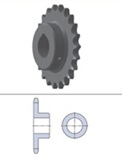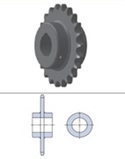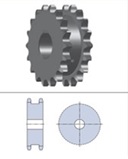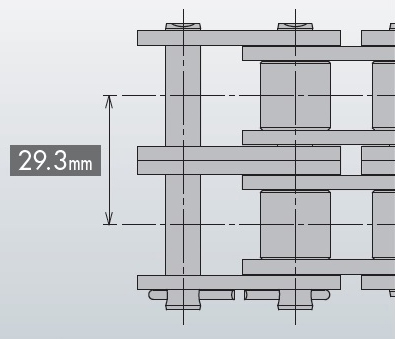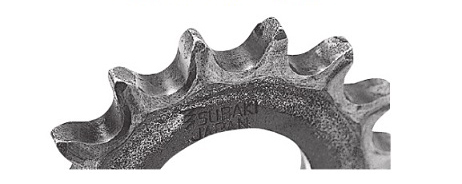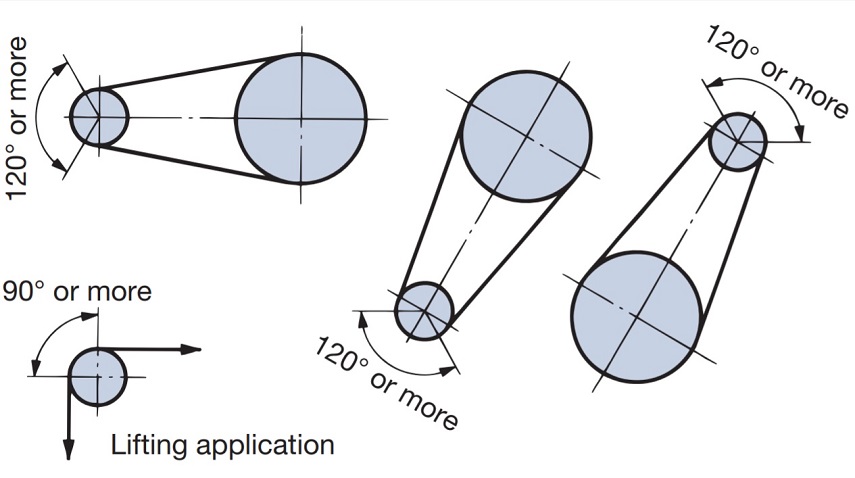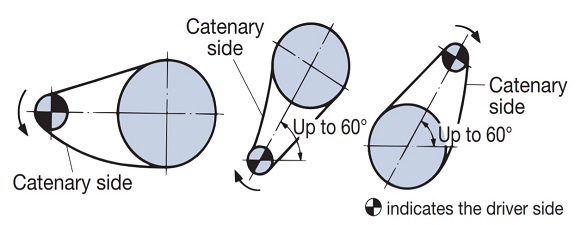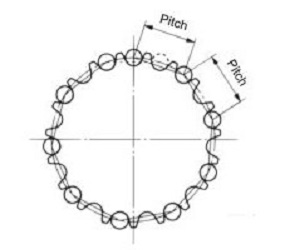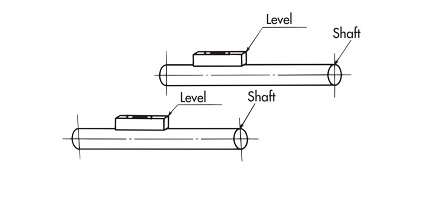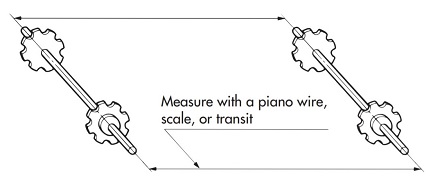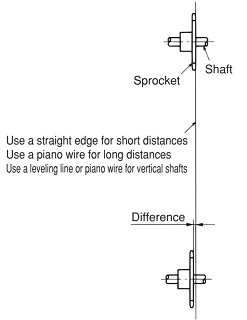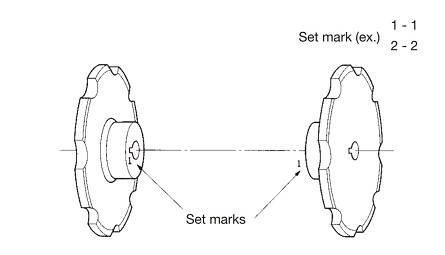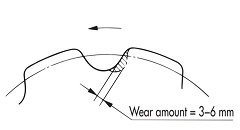Q&A Sprocket
The following is a list of answers for frequently asked questions from our customers. Select questions to view the answers.
Words
Sprocket in general
RS sprocket for drive chain
Sprocket for Small size conveyor chain
Sprocket for large size conveyor chains

| Q1 | How should I consider sprocket's selection? | |||||||||||||||||||||||||||||||||||||||||||||||||||||||||||||||||||||||||||||||||
|---|---|---|---|---|---|---|---|---|---|---|---|---|---|---|---|---|---|---|---|---|---|---|---|---|---|---|---|---|---|---|---|---|---|---|---|---|---|---|---|---|---|---|---|---|---|---|---|---|---|---|---|---|---|---|---|---|---|---|---|---|---|---|---|---|---|---|---|---|---|---|---|---|---|---|---|---|---|---|---|---|---|---|
| A1 |
It is necessary to select a sprocket that takes into consideration the model number and specifications of the chain to be used. The basic procedure is as follows.
|
|||||||||||||||||||||||||||||||||||||||||||||||||||||||||||||||||||||||||||||||||
| Q2 | What are the main materials used for sprockets? | |||||||||||||||||||||||||||||||||||||||||||||||||||||||||||||||||||||||||||||||||
| A2 |
Main materials for our sprocket are shown in the table below. Products listed in the catalog that do not have the lineup shown in the table below will be manufactured by quotation and made-to-order manufacturing. Contact us for details.
|
|||||||||||||||||||||||||||||||||||||||||||||||||||||||||||||||||||||||||||||||||
| Q3 | What kind of stainless steel is used for sprockets? Also, is there anything that can be teeth hardened (quenched)? | |||||||||||||||||||||||||||||||||||||||||||||||||||||||||||||||||||||||||||||||||
| A3 |
Materials used for stainless steel sprockets are shown in the table below. Please refer. Stainless steel sprockets listed in the catalogue are made of austenitic stainless steel (18-8SUS) and can not be hardened teeth (quenching) due to the characteristics of material. If teeth hardened (quenching) sprocket with stainless steel is required, martensitic stainless steel (SUS420 equivalent) make can be manufactured. (Quotation / Made-to-order product ) Also, sprockets with surface treated to increase hardness which is recommended for high strength stainless steel chain can be proposed. (Quotation / Made-to-order product ) Please contact us if you have any requests.
|
|||||||||||||||||||||||||||||||||||||||||||||||||||||||||||||||||||||||||||||||||
| Q4 | Is there a problem when using a combination of stainless steel and steel for sprockets and chains? | |||||||||||||||||||||||||||||||||||||||||||||||||||||||||||||||||||||||||||||||||
| A4 |
We recommend using the same material. Lineup of stainless steel sprockets is premised on the combination with stainless steel chains. For example, when stainless steel chains are used in combination with steel sprocket with plating, potentiometric corrosion (electrolytic corrosion) may occur, resulting in premature wear. |
|||||||||||||||||||||||||||||||||||||||||||||||||||||||||||||||||||||||||||||||||
| Q5 | Catalog says "tooth hardening" treatment. What kind of treatment is done on the sprocket? | |||||||||||||||||||||||||||||||||||||||||||||||||||||||||||||||||||||||||||||||||
| A5 |
"Teeth hardened" treatment described in the catalog is a treatment that hardens the surface by induction hardening. Teeth hardened is to improve wear resistance and strength. Generally, teeth hardened is performed when rpm is high (number of chain engagements per unit time is large), or when number of teeth is small and wrapping angle is small, or when wear inclusions are present. Generally, carbon steel for machine structure is used as the material for teeth hardened treatment, however structural alloy steel is also available upon request. Since it is a type of quenching treatment, it is also called "with teeth hardened treatment = quenching specifications" and "without teeth hardened treatment = unhardened specifications". |
|||||||||||||||||||||||||||||||||||||||||||||||||||||||||||||||||||||||||||||||||
| Q6 | What is the name of each part of sprocket? | |||||||||||||||||||||||||||||||||||||||||||||||||||||||||||||||||||||||||||||||||
| A6 |
The names of each part of sprocket are as follows. 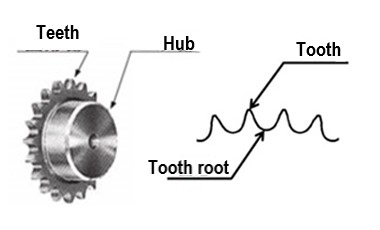


|
|||||||||||||||||||||||||||||||||||||||||||||||||||||||||||||||||||||||||||||||||
| Q7 | What is the "set screw" that comes standard with sprocket? | |||||||||||||||||||||||||||||||||||||||||||||||||||||||||||||||||||||||||||||||||
| A7 |
The standard set screw specification for our sprocket is "hexagonal hole set screw (cup point)". Basically, it is not attached to standard sprockets and special sprockets (quotation / made-to-order) other than Fit bores. If main unit is stainless steel type or plating type specification, a stainless steel set screw is attached. |
|||||||||||||||||||||||||||||||||||||||||||||||||||||||||||||||||||||||||||||||||
| Q8 | What is the shape of sprocket? | |||||||||||||||||||||||||||||||||||||||||||||||||||||||||||||||||||||||||||||||||
| A8 |
|
|||||||||||||||||||||||||||||||||||||||||||||||||||||||||||||||||||||||||||||||||
| Q9 | I would like to buy only A-shaped sprockets and weld the hub. Is there a problem? | |||||||||||||||||||||||||||||||||||||||||||||||||||||||||||||||||||||||||||||||||
| A9 |
Hub welding to A type sprockets may not be able to maintain quality due to the heat of weld. Avoid welding by yourself and contact us. |
|||||||||||||||||||||||||||||||||||||||||||||||||||||||||||||||||||||||||||||||||
| Q10 | After ordering, it was found that the sprocket hub diameter interfered with the layout. Is it okay to machining the hub? | |||||||||||||||||||||||||||||||||||||||||||||||||||||||||||||||||||||||||||||||||
| A10 |
We do not recommend it because there is a risk of accidents such as damage due to additional machining by the customer. |
|||||||||||||||||||||||||||||||||||||||||||||||||||||||||||||||||||||||||||||||||
| Q11 |
What does "pilot bore" in the catalog mean? Does it mean that the shaft bore dimensions can be manufactured within the range of "pilot bore diameter to maximum bore diameter" in the catalog? |
|||||||||||||||||||||||||||||||||||||||||||||||||||||||||||||||||||||||||||||||||
| A11 |
Pilot bore is a hole required in the process of manufacturing sprocket, and is basically not made with a tolerance suitable for shaft assembly. Shaft bore dimensions can be manufactured at appropriate tolerance within the range of pilot bore diameter +1mm to maximum bore diameter. |
|||||||||||||||||||||||||||||||||||||||||||||||||||||||||||||||||||||||||||||||||
| Q12 | How large is sprocket shaft bore capable of machining at most? | |||||||||||||||||||||||||||||||||||||||||||||||||||||||||||||||||||||||||||||||||
| A12 |
With bore processing of standard pilot bore type, it is less than or equal to "maximum bore diameter" in the dimension table listed for each model number of teeth in the catalog. For A type sprocket with no indication of maximum bore diameter, please contact us as we will consider manufacturing. |
|||||||||||||||||||||||||||||||||||||||||||||||||||||||||||||||||||||||||||||||||
| Q13 | What happens when using a bore diameter that exceeds the maximum shaft bore diameter? Is there any problem with a small hub thickness? | |||||||||||||||||||||||||||||||||||||||||||||||||||||||||||||||||||||||||||||||||
| A13 |
Hub thickness affects sprocket strength. Insufficient hub thickness may result in cracks or damage. Design the hub diameter and shaft bore diameter in consideration of sufficient strength based on the chain usage conditions so that the sprocket will not be damaged. We also offer TOUGH TOOTH sprocket recommended for Heavy Duty chain with increased hub strength without changing the size. Consider it when the hub strength is insufficient or the hub size cannot be changed due to space limitations.
|
|||||||||||||||||||||||||||||||||||||||||||||||||||||||||||||||||||||||||||||||||
| Q14 | What is position relation between sprocket teeth and keyway machining? Can I specify it? | |||||||||||||||||||||||||||||||||||||||||||||||||||||||||||||||||||||||||||||||||
| A14 |
Unless otherwise specified, keyway is machined in the following positions.
※Instructions are required if accuracy is required for keyway machining position, or if it is aligned with a specific tooth position. When requesting, instructions such as "phase alignment" and "parallel use" are required. |
|||||||||||||||||||||||||||||||||||||||||||||||||||||||||||||||||||||||||||||||||
| Q15 | Is it possible to perform a machining that specifies position relation between sprocket teeth and keyway? | |||||||||||||||||||||||||||||||||||||||||||||||||||||||||||||||||||||||||||||||||
| A15 |
Available as made-to-order. Please specify whether to align the keyway processing position at the center of "tooth tip" or "tooth root" as "phase alignment". Normally, Tsubaki aligns a phase at the center of tooth root for drive chain and Double pitch, and at the center of tooth tip for large size conveyor chains. Alignment accuracy is only visual. Please contact us If there are specific standards. ※If multiple sprockets are used on the same axis accurately, "parallel use" instruction is required. ※『Parallel use 』 : 「Q16.When using multiple sprockets on the same axis, what is the relative position relation of keyways? 」ReferenceTooth tip alignment 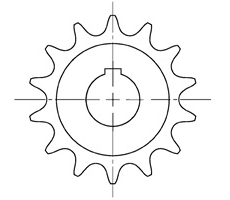
Tooth root alignment 
|
|||||||||||||||||||||||||||||||||||||||||||||||||||||||||||||||||||||||||||||||||
| Q16 | When using multiple sprockets on the same axis, what is the relative position relation of keyways? | |||||||||||||||||||||||||||||||||||||||||||||||||||||||||||||||||||||||||||||||||
| A16 |
Basically it is not considered. If the relative keyway positional relation to be considered, please specify "parallel use". In such a case, please check the following two points and specify. Alignment accuracy is only visual.
※It is different from "phase alignment" that matches position relation between keyway and teeth. When phase alignment is required, specify it separately. ※『Phase alignment 』 : 「Q15.Is it possible to perform a machining that specifies position relation between sprocket teeth and keyway? 」Reference2 pcs. 1 set (Hub in same direction ) 
2 pcs. 1 set (Hub outside-outside ) 
2 pcs. 1 set (Hub inside-inside ) 
4 pcs 1 set (3 pcs. in the same direction ) 
|
|||||||||||||||||||||||||||||||||||||||||||||||||||||||||||||||||||||||||||||||||
| Q17 | What is "Fit Bore" product? | |||||||||||||||||||||||||||||||||||||||||||||||||||||||||||||||||||||||||||||||||
| A17 |
"Fit bore" is a "sprocket with a finished shaft bore". In the sense of "Fit = fit, bore = make a hole", please select specifications from service range listed in the catalog. We will perform shaft bore processing of "shaft bore processing, keyway machining, tap hole machining" and deliver it to the customer in a state where it can be used immediately. There are "stock products with a finished shaft bore specified by us" and "made-to-order products with shaft hole processing selected by the customer". Shaft bore machining specifications can be selected from more than 100 million options from the TT-net drawing library.
In addition to sprockets, Fit Bore is also available for belt sprockets.
Back to questions
|
|||||||||||||||||||||||||||||||||||||||||||||||||||||||||||||||||||||||||||||||||
| Q18 | Can sprocket be delivered with bearings incorporated into it? | |||||||||||||||||||||||||||||||||||||||||||||||||||||||||||||||||||||||||||||||||
| A18 |
We will consider whether it can be manufactured or not. However, depending on the specifications and conditions, we may refuse it. Contact us for details.
Back to questions
|
|||||||||||||||||||||||||||||||||||||||||||||||||||||||||||||||||||||||||||||||||
| Q19 | What is a Lock Sprocket? | |||||||||||||||||||||||||||||||||||||||||||||||||||||||||||||||||||||||||||||||||
| A19 |
Lock Sprocket is a friction-locking sprocket that locks shaft and sprocket without using a key, and has the following features.
Be sure to use a torque wrench when tightening bolts. Sprocket will slip and rotate if it is not properly installed with the correct torque. Use a shaft diameter tolerance of h8 and a surface roughness of Ra3.2 as your standards. For other precautions, check the catalog and instruction manual, and use the product correctly.
|
|||||||||||||||||||||||||||||||||||||||||||||||||||||||||||||||||||||||||||||||||
| Q20 | Is it possible to manufacture a shaft diameter inch size with a Lock Sprocket? | |||||||||||||||||||||||||||||||||||||||||||||||||||||||||||||||||||||||||||||||||
| A20 |
Lock Sprocket does not have an inch series. Tsubaki Power Lock has an inch series, so please use Power Lock. |
|||||||||||||||||||||||||||||||||||||||||||||||||||||||||||||||||||||||||||||||||
| Q21 | Can Lock Sprockets be used on shafts with keyway processing? | |||||||||||||||||||||||||||||||||||||||||||||||||||||||||||||||||||||||||||||||||
| A21 |
Any shaft with a general keyway shape can be used. However, noted that an allowable transmission torque will be reduced by approx. 10%. This is because the contact area between a lock sleeve and a shaft is reduced by keyways. Also, even when using Tsubaki Power Lock, an allowable transmission torque will be reduced as well. |
|||||||||||||||||||||||||||||||||||||||||||||||||||||||||||||||||||||||||||||||||
| Q22 | Is it OK to mount sprocket with Power Lock on a shaft with keyway processing? | |||||||||||||||||||||||||||||||||||||||||||||||||||||||||||||||||||||||||||||||||
| A22 |
Any shaft with a general keyway shape can be used except EL series. However, noted that an allowable transmission torque will be reduced by approx. 10%. This is because the contact area between Power Lock and a shaft is reduced by keyways. Also, even when using a lock sprocket, an allowable transmission torque will be reduced as well. |
|||||||||||||||||||||||||||||||||||||||||||||||||||||||||||||||||||||||||||||||||
| Q23 | I'm considering a Lock Sprocket. Can surface treatment be applied to Lock Sprocket? | |||||||||||||||||||||||||||||||||||||||||||||||||||||||||||||||||||||||||||||||||
| A23 |
Depends on the content of surface treatment, quotation will be available as made-to-order products.
Back to questions
|
|||||||||||||||||||||||||||||||||||||||||||||||||||||||||||||||||||||||||||||||||
| Q24 | Is stainless steel Lock Sprocket available? | |||||||||||||||||||||||||||||||||||||||||||||||||||||||||||||||||||||||||||||||||
| A24 |
Lock sprockets made by stainless steel are not available. When stainless steel type with friction locking are requested, the combination of Tsubaki Power Lock (stainless steel specification) and Tsubaki RS sprocket (stainless steel specification) is recommended. |
|||||||||||||||||||||||||||||||||||||||||||||||||||||||||||||||||||||||||||||||||
| Q25 | What kind of surface treatment is possible? | |||||||||||||||||||||||||||||||||||||||||||||||||||||||||||||||||||||||||||||||||
| A25 |
Surface treatment is performed to improve corrosion and wear resistance as well as appearance qualities by applying heat treatment and chemical reactions to metallic surfaces. Typical surface treatments we are implementing are following three. (※Please contact us as there are restrictions depending on the size. )
In addition, "TOUGH TOOTH" sprocket recommended for Heavy Duty chain has a surface hardness of HV800 or higher. Basically, plating is not processed on shaft bore inner diameter.
|
|||||||||||||||||||||||||||||||||||||||||||||||||||||||||||||||||||||||||||||||||
| Q26 | I would like to have plating treatment on sprocket. What points should be caution? | |||||||||||||||||||||||||||||||||||||||||||||||||||||||||||||||||||||||||||||||||
| A26 |
We do not recommend that the customer surface-treat the product after purchase, as it may cause a decrease in strength.
Back to questions
|
|||||||||||||||||||||||||||||||||||||||||||||||||||||||||||||||||||||||||||||||||
| Q27 | What kind of sprocket should be chosen for Tsubaki Lube-Free chain "Lambda Chain"? | |||||||||||||||||||||||||||||||||||||||||||||||||||||||||||||||||||||||||||||||||
| A27 |
When selecting two or more strands, pay attention to the transverse pitch of chain.
|
|||||||||||||||||||||||||||||||||||||||||||||||||||||||||||||||||||||||||||||||||
| Q28 | Can you manufacture sprockets with shear pins? | |||||||||||||||||||||||||||||||||||||||||||||||||||||||||||||||||||||||||||||||||
| A28 |
We can not decide specification for dimension and tensile strength. If you do not provide detailed conditions, we apologize for the inconvenience, but we will refuse it due to quality assurance issues. |
|||||||||||||||||||||||||||||||||||||||||||||||||||||||||||||||||||||||||||||||||
| Q29 | Does sprocket comply with RoHS Directive? | |||||||||||||||||||||||||||||||||||||||||||||||||||||||||||||||||||||||||||||||||
| A29 |
All of our sprockets comply with RoHS Directive. If you need a certificate, please request issuance via dealer/retailer where you purchased the product. ※RoHS Directive is subject to revision. |
|||||||||||||||||||||||||||||||||||||||||||||||||||||||||||||||||||||||||||||||||
| Q30 | I will send a picture of sprocket, so could you identify specification? | |||||||||||||||||||||||||||||||||||||||||||||||||||||||||||||||||||||||||||||||||
| A30 |
We cannot identify specification in the picture because its hard to identify it only by the appearance. We apologize for the inconvenience, but we have declined your request. |
|||||||||||||||||||||||||||||||||||||||||||||||||||||||||||||||||||||||||||||||||
| Q31 | There is an actual sprocket. Is it possible to send it and make the same one? | |||||||||||||||||||||||||||||||||||||||||||||||||||||||||||||||||||||||||||||||||
| A31 |
It is possible to help you specify the specifications by requesting a quote. However, even after checking the actual product, it may not be possible to identify specification. Also, please note that we are not responsible for specification even if we reply to quotation. If it is a used product, it is difficult to identify the specifications with detailed dimensions because the original shape is not retained. If it is severely damaged, even rough specification identification may not be possible. It may not be possible to identify the material. We ask the customer to make the final decision for the specifications with reference to our views. |
|||||||||||||||||||||||||||||||||||||||||||||||||||||||||||||||||||||||||||||||||
| Q32 | Please tell me what to be careful about when storing sprockets. | |||||||||||||||||||||||||||||||||||||||||||||||||||||||||||||||||||||||||||||||||
| A32 |
Do not store the product in an environment where it is exposed to dust, direct rain, high temperature, freezing, or corrosive atmosphere. Please apply oil with a brush to prevent rusting. Particularly, please pay attention to the no painted products, or no painted part of the painted products, such as shaft bores. |
|||||||||||||||||||||||||||||||||||||||||||||||||||||||||||||||||||||||||||||||||
| Q33 | Is grease effective as a sprocket drive lubricant? | |||||||||||||||||||||||||||||||||||||||||||||||||||||||||||||||||||||||||||||||||
| A33 |
Greasing may be effective at the engagement part of sprocket and chain at low speeds and high loads. However, in places with a lot of dust, wear may be accelerated by absorbing and sticking dust. In addition, lubrication between pin and bush is crucial to reduce chain wear elongation. Grease may be applied to prevent the oil supplied to chain from flowing out due to external factors (wind and rain, etc.). Conversely, if the grease interferes with the oil supply between pin and bush of chain, lube effect may be decreased. So please consider it carefully. |
|||||||||||||||||||||||||||||||||||||||||||||||||||||||||||||||||||||||||||||||||
| Q34 | The chain has worn out and is scheduled to be replaced. The appearance of sprocket is beautiful, so I'm wondering if it can be used as it is. | |||||||||||||||||||||||||||||||||||||||||||||||||||||||||||||||||||||||||||||||||
| A34 |
Wear of sprocket cannot be judged from the beautiful appearance. Since sprocket is worn as well as chain, please check and judge if there is no abnormality such as wear by the inspection method described in the catalog or instruction manual. |
|||||||||||||||||||||||||||||||||||||||||||||||||||||||||||||||||||||||||||||||||
| Q35 | I feel wear on sprocket tooth surface is too fast. What may be the cause? | |||||||||||||||||||||||||||||||||||||||||||||||||||||||||||||||||||||||||||||||||
| A35 |
The table below summarizes possible causes and remedies for wear on a sprocket tooth (root, tooth pressing surface).
|
|||||||||||||||||||||||||||||||||||||||||||||||||||||||||||||||||||||||||||||||||
| Q36 | The sides of sprocket teeth are worn. What could be the cause? | |||||||||||||||||||||||||||||||||||||||||||||||||||||||||||||||||||||||||||||||||
| A36 |
The table below summarizes the possible causes and remedies. Wear on the inside of chain link plate may be also considered. Check a chain as well.
|
|||||||||||||||||||||||||||||||||||||||||||||||||||||||||||||||||||||||||||||||||
| Q37 | Sometimes the chain is riding up on the sprocket. What are the causes? | |||||||||||||||||||||||||||||||||||||||||||||||||||||||||||||||||||||||||||||||||
| A37 |
The table below summarizes the possible causes and remedies. If left unattended, it may lead to sudden breakage of the plate (Fig. 2), so be sure to inspect and take measures.
|
|||||||||||||||||||||||||||||||||||||||||||||||||||||||||||||||||||||||||||||||||
| Q38 | What is Indicator pins? | |||||||||||||||||||||||||||||||||||||||||||||||||||||||||||||||||||||||||||||||||
| A38 |
Indicators pin is a replacement notice mark. The sprocket has a wear limit mark, and when the tooth wear reaches the mark, the service life is judged to be the limit of use. There are following advantages.
Replacement time can be confirmed at a glance, and inspection time and labor can be greatly reduced. Anyone without skill can make an accurate life judgment. Change from hand inspection to visual inspection. Minimal contacts increase safety of inspection. Large Size Conveyor Chain Sprockets Smart Replaceable Series and RS large size sprocket for drive chain have this function, however its can be equipped on other sprockets upon request. Previous inspections 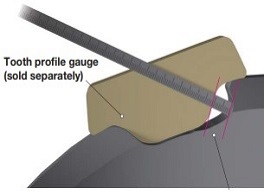
Measures the gap between the worn tooth and the tooth profile gauge Inspection using Indicator Pins Sprocket replacement timing can be judged at a glance. 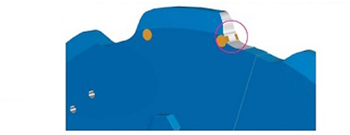
|
|||||||||||||||||||||||||||||||||||||||||||||||||||||||||||||||||||||||||||||||||
| Q39 | Do you have a sprocket that is easy to inspect? | |||||||||||||||||||||||||||||||||||||||||||||||||||||||||||||||||||||||||||||||||
| A39 |
Sprocket equipped with Indicator Pins (replacement notice mark) to confirm replacement timing at a glance is available. Equipped as standard on Smart Replaceable Series of sprockets (Split Type, Ring Replaceable Tooth Type, Block Replaceable Tooth Type) that are frequently replaced. Standard sprocket with Indicator Pins is identified as "Tsubaki Blue Collar Paint". In addition to large size sprockets for drive chain, other conveyor chain sprockets are also available upon request. ※『Indicator pins 』 : 「Q38.What is Indicator pins? 」ReferenceInspection using Indicator Pins Sprocket replacement timing can be judged at a glance. 
Equipped in 2 places every 180 ° 
|
|||||||||||||||||||||||||||||||||||||||||||||||||||||||||||||||||||||||||||||||||
| Q40 | Where can I place an order to buy sprockets? How long does it take to deliver? | |||||||||||||||||||||||||||||||||||||||||||||||||||||||||||||||||||||||||||||||||
| A40 |
We do not sell directly, so please contact your retailer or retailer. Please contact them for for delivery too. |
|||||||||||||||||||||||||||||||||||||||||||||||||||||||||||||||||||||||||||||||||
| Q41 | What standard is tooth profile of sprocket for drive chain? | |||||||||||||||||||||||||||||||||||||||||||||||||||||||||||||||||||||||||||||||||
| A41 |
JIS standard S-tooth profile is used for Tsubaki RS sprocket's tooth profile. (JIS standard U-tooth profile is also used for some sprockets. ) Other special tooth profile are available, such as for BS tooth profile, heavy duty chain or pin gearing. |
|||||||||||||||||||||||||||||||||||||||||||||||||||||||||||||||||||||||||||||||||
| Q42 | Is it necessary to calculate the strength of teeth when selecting a sprocket? | |||||||||||||||||||||||||||||||||||||||||||||||||||||||||||||||||||||||||||||||||
| A42 |
Generally, if working load is less than maximum allowable load of the chain, sprocket tooth will not bend or break, so select it listed in the catalog. However, dedicated sprocket also might be consider for heavy duty type chains. Load distribution of each tooth in wrapping transmission is complicated, so it is calculated with one tooth. However, actual chain load is shared by several teeth due to wrapping transmission, its not shared with one tooth. Load distribution of each tooth 
|
|||||||||||||||||||||||||||||||||||||||||||||||||||||||||||||||||||||||||||||||||
| Q43 | When does sprocket for drive chain require "tooth hardening treatment"? What is the reason for "with tooth hardening treatment" and "without tooth hardening treatment" in the catalogue? | |||||||||||||||||||||||||||||||||||||||||||||||||||||||||||||||||||||||||||||||||
| A43 |
For drive chains, sprocket that meets the following usage conditions is teeth hardened.
Back to questions
|
|||||||||||||||||||||||||||||||||||||||||||||||||||||||||||||||||||||||||||||||||
| Q44 | Is life of sprocket same for all manufacturers? | |||||||||||||||||||||||||||||||||||||||||||||||||||||||||||||||||||||||||||||||||
| A44 |
Depends on manufacturer. Life is reached mainly due to the wear of tooth part. So, we have implemented wear resistance focused "teeth hardening treatment." This is a common Induction hardening, however even when compared to other companies, wear of the teeth is different in long-term use due to deep and uniform heat treatment. "Hardening" is one of Tsubaki's strengths. Consider Tsubaki sprocket which has an advantage in wear resistance.
Cross-section comparison of teeth hardening treatment (Discolored part of teeth is hardened layer )
|
|||||||||||||||||||||||||||||||||||||||||||||||||||||||||||||||||||||||||||||||||
| Q45 | What is the operating temperature range for sprocket? | |||||||||||||||||||||||||||||||||||||||||||||||||||||||||||||||||||||||||||||||||
| A45 |
Appropriate operating temperature range for RS sprocket is -10 ° C to 150 ° C, and for RS sprocket stainless steel series is -20 ° C to 400 ° C. Not only strength changes due to temperature but also constraints due to chain lubricant must be considered. |
|||||||||||||||||||||||||||||||||||||||||||||||||||||||||||||||||||||||||||||||||
| Q46 | Can standard RS sprockets be used in an environment where Cold Resistant drive chain is used (-10°C or less)? | |||||||||||||||||||||||||||||||||||||||||||||||||||||||||||||||||||||||||||||||||
| A46 |
Standard sprockets listed in the catalog are not recommended to use at low temperatures of -10 ° C or lower, because they are made of carbon steel or rolled steel for machine structure and will reduce strength. In some cases, custom sprockets made of special materials can be offered as a countermeasure. Please contact us for products in an operating temperature range not listed in the catalog. |
|||||||||||||||||||||||||||||||||||||||||||||||||||||||||||||||||||||||||||||||||
| Q47 | Can standard RS sprockets be used for Heavy Duty drive chains? | |||||||||||||||||||||||||||||||||||||||||||||||||||||||||||||||||||||||||||||||||
| A47 |
Standard sprocket with tooth hardening treatment can be used, however there are many cases where key surface pressure is insufficient. "TOUGH TOOTH" is available as a recommended sprocket for Heavy Duty Drive Chains, so please consider it. The stronger the chain, the more important it is to check the key surface pressure, etc. Double keys or lengthened hubs can decrease surface pressure. However, from the viewpoint of space saving and pricing, we recommend "TOUGH TOOTH" with higher hub strength. Also, when using H-class chains such as HT Heavy Duty chains and Super-H chains in multiple strands, standard RS sprockets cannot be used because the transverse pitch of the teeth is different. |
|||||||||||||||||||||||||||||||||||||||||||||||||||||||||||||||||||||||||||||||||
| Q48 | Can standard RS sprockets be used for BS standard chains? | |||||||||||||||||||||||||||||||||||||||||||||||||||||||||||||||||||||||||||||||||
| A48 |
JIS standard RS sprocket cannot be used because the basic 3 dimensions (pitch, roller diameter, inner width of inner link) are different. BS/DIN standard dedicated sprocket for BS standard chains are available. |
|||||||||||||||||||||||||||||||||||||||||||||||||||||||||||||||||||||||||||||||||
| Q49 | Can standard RS sprockets be used for Pin Gears? | |||||||||||||||||||||||||||||||||||||||||||||||||||||||||||||||||||||||||||||||||
| A49 |
Dedicated sprocket with a special tooth profile is required. It is different from JIS standard RS sprocket, and has a tooth profile suitable for wrapping transmission. For linear and rotary motions of objects, roller chain or gear is generally used from a drive source (motor, etc.) via a reducer. Wrapping transmission using roller chains require more space, and gears require precision machining, and both are costly. Pin gear drive is optimal in such cases. For pin gear drive, as shown in Fig. 1, attachment chain for chain type pin gear instead of a wheel is wrapped around the outer circumference of a drum or table. And a special tooth profile sprocket (pin gear sprocket) instead of the pinion gear is used. Also as shown in Fig. 2, for linear motion, instead of the rack, attachment chain for chain type pin gear is installed in a straight line. "Pin Gear Drive Unit" that includes a pin gear and a wheel or rack is also on sale. 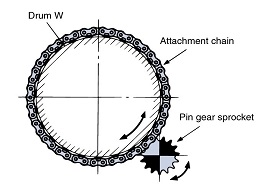
[Fig. 1] 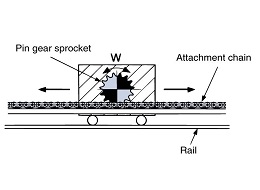
[Fig. 2] |
|||||||||||||||||||||||||||||||||||||||||||||||||||||||||||||||||||||||||||||||||
| Q50 | Can chain tensioners be manufactured? | |||||||||||||||||||||||||||||||||||||||||||||||||||||||||||||||||||||||||||||||||
| A50 |
We have standardized tensioner and idlers. Please consider from our specifications. |
|||||||||||||||||||||||||||||||||||||||||||||||||||||||||||||||||||||||||||||||||
| Q51 | What causes sprocket uneven rotation, and how can I stop it? | |||||||||||||||||||||||||||||||||||||||||||||||||||||||||||||||||||||||||||||||||
| A51 |
One of causes of uneven rotation is speed variation of chain. Chain engages polygonally with sprocket. Therefore, as shown in the figure below, the height of engagement (radius from the center of sprocket) differs between when engaging at the tangential position of the circle and when engaging at the chord position. As a result, even if the drive sprocket is rotating at a constant speed, the traveling speed of chain will vary by the radius ratio. Speed variation rate is calculated by the following formula. Speed variation rate =(V2-V1)/V2=1-cos(180°/Z) (Z is the number of teeth ) As the number of teeth increases, rotation becomes smoother and enables smooth transmission, so it is generally recommended to have 15 or more teeth. V2 chain speed maximum V1 chain speed minimum 
Due to the speed fluctuation of chain and the nature of sprocket, the driven sprocket will have uneven rotation. In addition, the effects of sprocket eccentric mounting errors and chain and sprocket manufacturing errors are also added. Increasing the number of teeth on drive sprocket (larger diameter) will result in smoother transmission and less uneven rotation. |
|||||||||||||||||||||||||||||||||||||||||||||||||||||||||||||||||||||||||||||||||
| Q52 | The drive chain is vibrating. Can sprockets be the cause? Also, are there any countermeasures? | |||||||||||||||||||||||||||||||||||||||||||||||||||||||||||||||||||||||||||||||||
| A52 |
Sprockets can also be the cause. The causes and countermeasures are as follows. Polygonal motion When chordal action (vertical motion due to sprocket and chain polygonal motion) is involved, it is possible to suppress the polygonal motion by selecting the largest number of teeth possible. Generally, 15 or more teeth are recommended. ※『Cordal action 』 : 「Q51.What causes sprocket uneven rotation, and how can I stop it? 」Reference |
|||||||||||||||||||||||||||||||||||||||||||||||||||||||||||||||||||||||||||||||||
| Q53 | How much is the proper speed ratio and chain wrap angle of RS sprocket for drive chain? | |||||||||||||||||||||||||||||||||||||||||||||||||||||||||||||||||||||||||||||||||
| A53 |
Speed ratio of roller chain transmission is usually up to 7: 1. Up to about 10: 1 is possible only at very low speeds.
|
|||||||||||||||||||||||||||||||||||||||||||||||||||||||||||||||||||||||||||||||||
| Q54 | How much is the appropriate shaft center distance of RS-sprockets for drive chain? | |||||||||||||||||||||||||||||||||||||||||||||||||||||||||||||||||||||||||||||||||
| A54 |
The minimum distance is fine as long as the teeth of the two sprockets are not in contact. The optimum center distance between the shafts is about 30 to 50 times the pitch of roller chain used. However, if the load is flactuating, a distance of 20 times or less is suitable. About 30 to 50 times the pitch of roller chain
|
|||||||||||||||||||||||||||||||||||||||||||||||||||||||||||||||||||||||||||||||||
| Q55 | Is layout arrangement of RS sprocket for drive chain determined? | |||||||||||||||||||||||||||||||||||||||||||||||||||||||||||||||||||||||||||||||||
| A55 |
General layout of roller chain transmission is as follows.
|
|||||||||||||||||||||||||||||||||||||||||||||||||||||||||||||||||||||||||||||||||
| Q56 | Are there any layouts / arrangements that require special attention for RS sprockets for drive chains? | |||||||||||||||||||||||||||||||||||||||||||||||||||||||||||||||||||||||||||||||||
| A56 |
Caution is required for layout in the following cases. Please use an idler/tensioner.
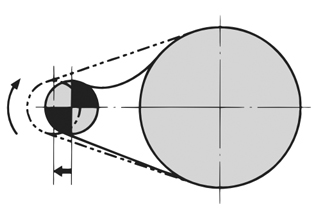
Fig. 1) Layout when the center distance is short 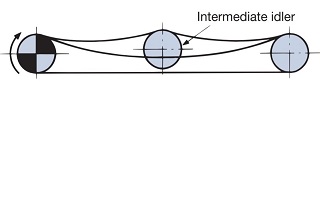
Fig. 2) Layout when the center distance is long 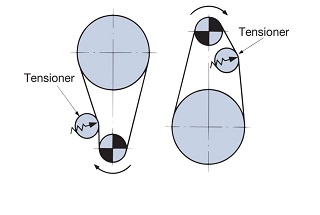
Fig. 3) Vertical transmission |
|||||||||||||||||||||||||||||||||||||||||||||||||||||||||||||||||||||||||||||||||
| Q57 | Please tell me installation precision and installation procedure of RS sprocket for drive chain. | |||||||||||||||||||||||||||||||||||||||||||||||||||||||||||||||||||||||||||||||||
| A57 |
Install correctly as described below, paying attention to the horizontal precision and parallelism of the shafts.
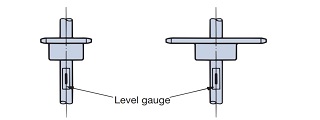
Fig. 1) Horizontal precision of the shafts 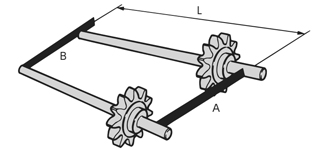
Fig. 2) Parallelism of the shafts 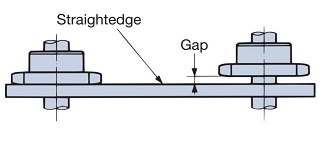
Fig. 3) Sprocket alignment |
|||||||||||||||||||||||||||||||||||||||||||||||||||||||||||||||||||||||||||||||||
| Q58 | How long does RS sprocket for drive chains last? What are the points of inspection? | |||||||||||||||||||||||||||||||||||||||||||||||||||||||||||||||||||||||||||||||||
| A58 |
As a guideline for life and replacement, check wear of the teeth. The strength of sprocket is reduced by wear of the teeth, which adversely affects chain transmission. Replace with a new sprocket before it becomes defective through regular inspections. The check points are as follows.
To reduce inspection labors and improve safety, sprockets with Indicator Pins to confirm replacement timing at a glance is available. Usage limit of tooth thickness / Dimension B table
Forward and reverse One direction Usage limit of tooth thickness / Dimension B (Fig. ) 
Fig. 2) The sides of teeth are shaved. |
|||||||||||||||||||||||||||||||||||||||||||||||||||||||||||||||||||||||||||||||||
| Q59 | Please tell me symptoms of improper installation of RS sprocket for drive chain and points of inspection. | |||||||||||||||||||||||||||||||||||||||||||||||||||||||||||||||||||||||||||||||||
| A59 |
【Symptoms 】 If any of the following symptoms occur, check sprocket and its installation again.
【Inspection points 】 Cause can be determined from the inspection of sprocket engagement. If it is not normal, check and correct it again.
The cause of abnormality is that the sprocket is not installed properly or the roller chain is twisted. If any abnormality is found, the sprocket as it is will adversely affect roller chain transmission, so replace it with new sprockets. 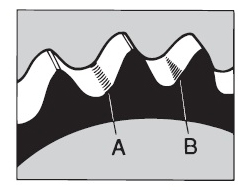
Fig. 1) Contact area of the sprocket teeth 
Fig. 2) The sides of teeth are shaved. |
|||||||||||||||||||||||||||||||||||||||||||||||||||||||||||||||||||||||||||||||||
| Q60 | Can RS sprocket for drive chain be used for Double Pitch S roller Chain? | |||||||||||||||||||||||||||||||||||||||||||||||||||||||||||||||||||||||||||||||||
| A60 |
RS sprockets with the number of teeth is 29 or less teeth cannot be used with Double Pitch S-roller, and Double Pitch Sprocket is required. If the number of teeth is 30 or more, a standard RS sprocket for drive chains can be used. (※This is because the pitch circle diameter = PCD is an approximate value when the number of teeth is 30 or more. ) In addition, standard RS sprocket cannot be used in multiple strands of RF2060 or larger because transverse pitch is different. Since these chains are considered special, special sprockets can also be manufactured based on the chain drawings. |
|||||||||||||||||||||||||||||||||||||||||||||||||||||||||||||||||||||||||||||||||
| Q61 | Can RS sprocket for drive chain be used for small size conveyor chains? | |||||||||||||||||||||||||||||||||||||||||||||||||||||||||||||||||||||||||||||||||
| A61 |
RS sprocket for drive chain can be used for RS attachment chain for small size conveyors. However, noted if sprocket diameter is small or attachment is special, it is necessary to consider interference with the sprocket. Use double pitch sprocket for double pitch chain. However, RS sprocket can be used if the number of teeth is 30 or more with Double Pitch S-roller. |
|||||||||||||||||||||||||||||||||||||||||||||||||||||||||||||||||||||||||||||||||
| Q62 | Why are odd-numbered teeth recommended for Double pitch sprockets dedicated to Double pitch (S rollers)? | |||||||||||||||||||||||||||||||||||||||||||||||||||||||||||||||||||||||||||||||||
| A62 |
It is recommended because the wear life will be longer if actual number of teeth is odd with S roller. For Double Pitch sprocket, the number of teeth that actually engage is called the effective number of teeth, and the number of apparent teeth is called the actual number of teeth.If the base chain rollers are S rollers, the chain engages with every other tooth. (Fig. 1 ) When actual number of teeth is odd for S roller (Fig. 3), the rollers in the first rotation engage every second tooth in the order of numbers 1 to 10. However, from the second rotation, it starts engaging with tooth number 11 that is different from the previous rotation. The rollers engage with different teeth for each rotation of the sprocket, resulting in less wear and longer life. For R roller, it engages with each tooth. (Fig. 2 ) |
|||||||||||||||||||||||||||||||||||||||||||||||||||||||||||||||||||||||||||||||||
| Q63 | Use hollow pin double pitch. What kind of sprockets can be used? | |||||||||||||||||||||||||||||||||||||||||||||||||||||||||||||||||||||||||||||||||
| A63 |
RS sprocket for drive chain can be used when the number of teeth is 30 or more as with standard RF Double pitch. Double Pitch sprocket is required as they cannot be used with 29 teeth or less. Standard RS sprocket cannot be used in multiple strands of RF2060 or larger because transverse pitch is different. Since these chains are considered special, special sprockets can also be manufactured based on the chain drawings. |
|||||||||||||||||||||||||||||||||||||||||||||||||||||||||||||||||||||||||||||||||
| Q64 | Please tell me installation precision and installation procedure of small size conveyor chains. | |||||||||||||||||||||||||||||||||||||||||||||||||||||||||||||||||||||||||||||||||
| A64 |
Install correctly as described below, paying attention to the horizontal precision and parallelism of the shafts.
Fig. 1 Measurement of horizontal precision Fig. 2 Measurement of parallelism of the shafts |
|||||||||||||||||||||||||||||||||||||||||||||||||||||||||||||||||||||||||||||||||
| Q65 | How long does Double pitch sprocket for small size conveyor chains last? What are the points of inspection? | |||||||||||||||||||||||||||||||||||||||||||||||||||||||||||||||||||||||||||||||||
| A65 |
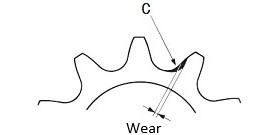
Fig. 2 Sprocket tooth wear 
Fig. 3 Sprocket tooth wear (side ) |
|||||||||||||||||||||||||||||||||||||||||||||||||||||||||||||||||||||||||||||||||
| Q66 | What is minimum number of teeth for large size conveyor chain sprocket? | |||||||||||||||||||||||||||||||||||||||||||||||||||||||||||||||||||||||||||||||||
| A66 |
The number of teeth must be 6 or more in consideration of chain engagement. |
|||||||||||||||||||||||||||||||||||||||||||||||||||||||||||||||||||||||||||||||||
| Q67 | Is it possible to manufacture A type sprocket without hubs for large size conveyor chain? | |||||||||||||||||||||||||||||||||||||||||||||||||||||||||||||||||||||||||||||||||
| A67 |
It is possible as a made-to-order product, so please give us an inquiry. If it is supposed to be welded, it may lead to defects depending on the material. |
|||||||||||||||||||||||||||||||||||||||||||||||||||||||||||||||||||||||||||||||||
| Q68 | Does sprocket for large size conveyor chain have hanging holes? | |||||||||||||||||||||||||||||||||||||||||||||||||||||||||||||||||||||||||||||||||
| A68 |
Sprockets with hanging holes can be checked in the catalog. For those with hanging holes, in addition to the sprocket dimension table, the hanging hole dimensions and the number of hanging holes are specified in the hanging hole dimension list. Hanging holes are not available on sprockets with numbers of teeth or chain numbers not listed. If you wish, we will make an estimate after considering manufacturing, so please specify the specific position, size, and quantity. |
|||||||||||||||||||||||||||||||||||||||||||||||||||||||||||||||||||||||||||||||||
| Q69 | Please tell me installation precision and installation procedure of large size conveyor chains. | |||||||||||||||||||||||||||||||||||||||||||||||||||||||||||||||||||||||||||||||||
| A69 |
Install correctly as described below, paying attention to the horizontal precision and parallelism of the shafts.
※Installation accuracy is a general value viewed from the conveyor chain itself. Follow accuracy constraints of the conveyor main unit, if any. Fig. 1 Measurement of horizontal precision Fig. 2 Measurement of parallelism of the shafts |
|||||||||||||||||||||||||||||||||||||||||||||||||||||||||||||||||||||||||||||||||
| Q70 | How long does sprocket for large size conveyor chain last? What are the points of inspection? | |||||||||||||||||||||||||||||||||||||||||||||||||||||||||||||||||||||||||||||||||
| A70 |
Use Fig. 1 as a guide for wear limit of sprocket tooth surface. The life is 3 to 6 mm depending on the size. If the chain engages with the worn sprocket teeth, it will have adverse effects such as faster chain wear. If the teeth are worn, replace them. If the sides of sprocket teeth are worn, refer to Table 1 and take corrective action. To reduce inspection labors and improve safety, sprockets with Indicator Pins to confirm replacement timing at a glance is available.
|
|||||||||||||||||||||||||||||||||||||||||||||||||||||||||||||||||||||||||||||||||

